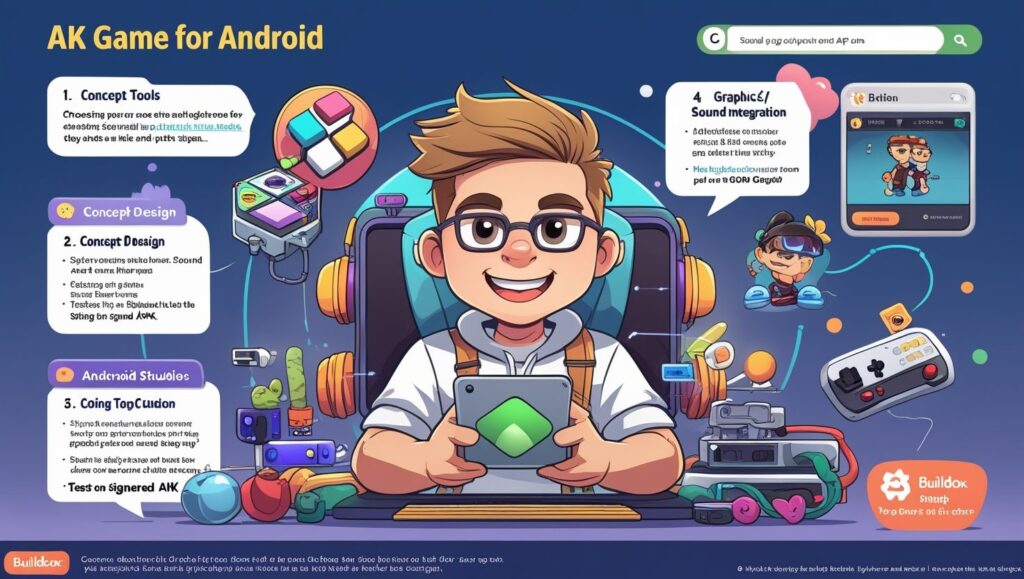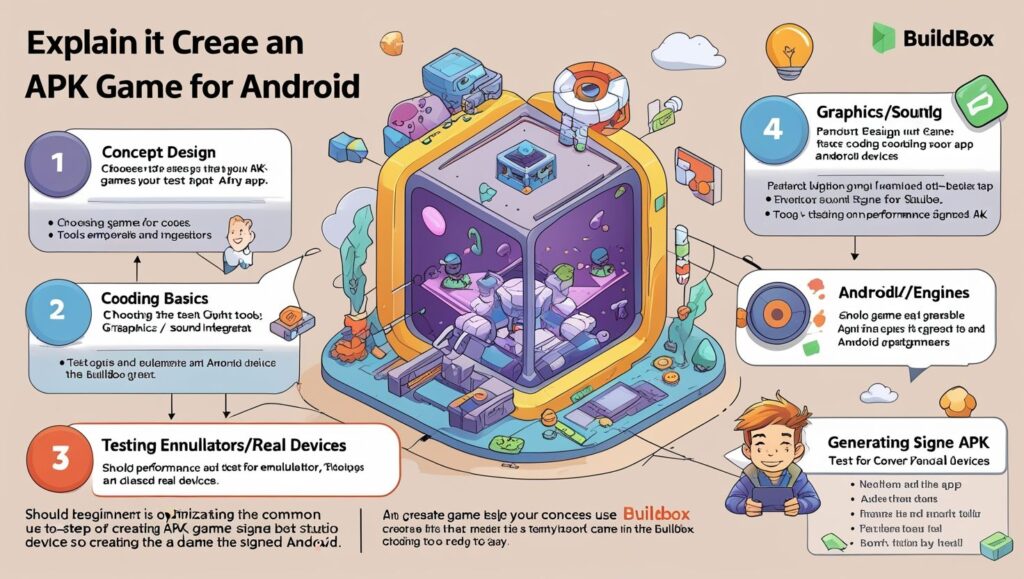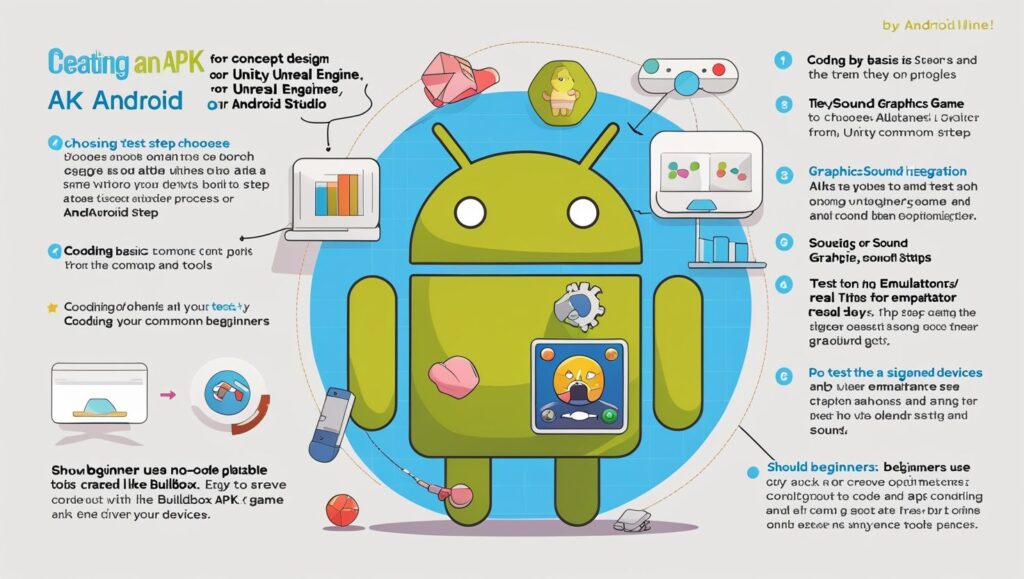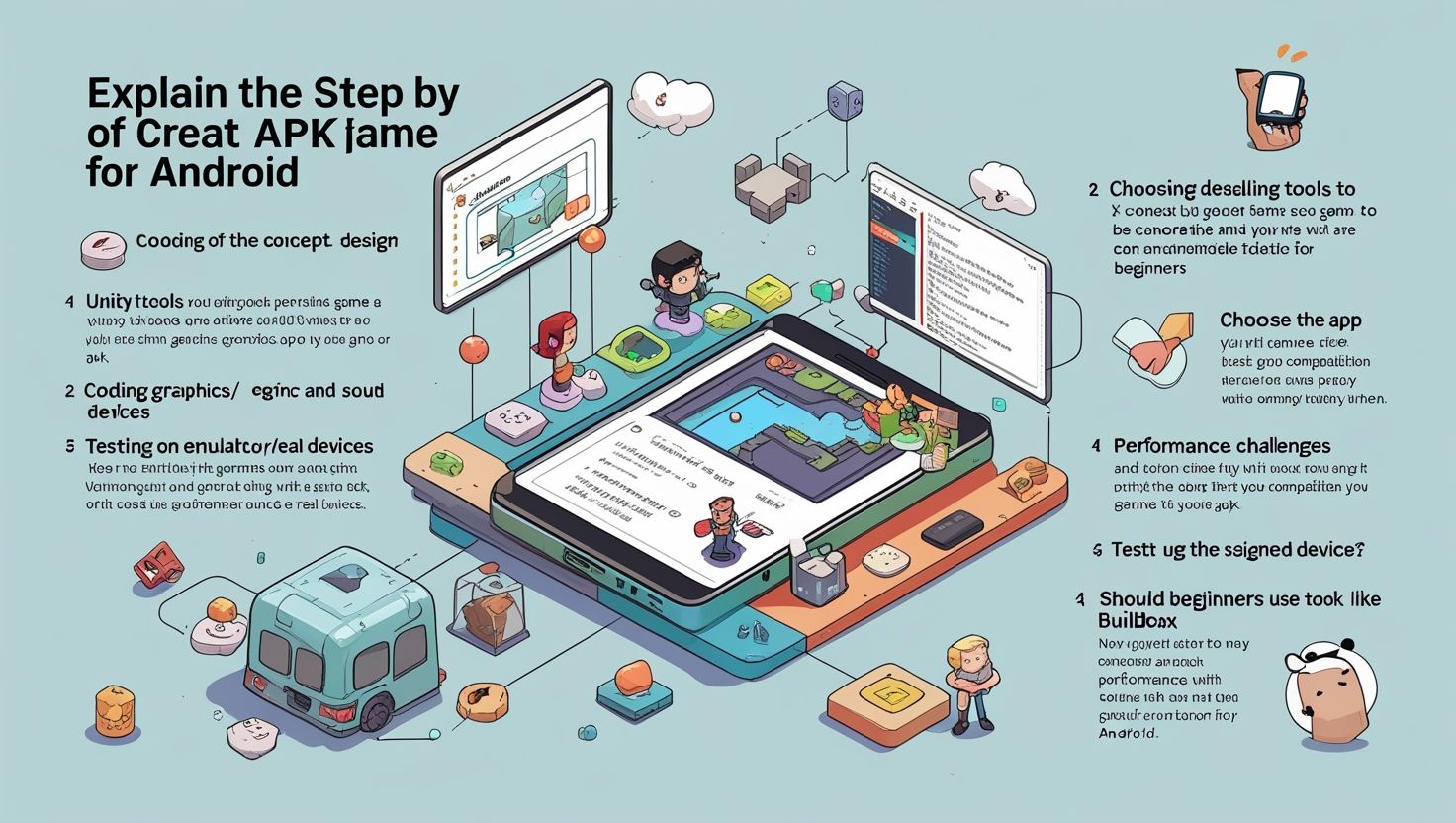1. Introduction
How to Create APK Games, APK (Android Package Kit) games are the backbone of mobile entertainment on Android devices. These game files come with the .apk extension and are installed on Android phones and tablets. With the ever-growing Android user base, creating APK games is not just exciting but also potentially profitable. APK games range from simple 2D puzzles to complex 3D adventures. Many indie developers and game studios are leveraging the accessibility of Android Studio and game engines like Unity and Unreal to produce engaging content. Understanding the fundamentals of how APK files work, what makes Android such a popular gaming platform, and the potential for monetization is crucial before beginning development. With the right tools, creativity, and a strong plan, anyone with basic programming knowledge can dive into this industry. This article outlines the complete process — from planning your game to publishing a fully functional APK on the Google Play Store or sharing it directly with users.
2. Planning Your Game Idea
Every successful game begins with a solid idea. Planning is the blueprint that guides the entire development process. Start by defining the type of game you want to create — puzzle, platformer, action, RPG, or educational. Then, think about the core mechanics: What will the player do? What makes the game fun? Identify your target audience and platforms (phones, tablets). Create a design document that outlines game objectives, characters, environments, UI flow, and progression. Sketch out levels or gameplay using paper or tools like Figma. Consider story elements if needed. Planning helps prevent major issues later and keeps development organized. Keep it realistic based on your time, budget, and skill level. Decide early if you’re working solo or in a team. Assign responsibilities like coding, art, sound, and testing. Remember, game development is iterative — your plan can evolve, but having a clear roadmap increases your chances of success and makes the entire process smoother and more manageable.
3. Choosing the Right Game Engine
A game engine is a software framework used to build and run games. Choosing the right engine is a critical decision that determines how efficiently you can create your APK game. The most popular options include Unity, Unreal Engine, and Godot. Unity is beginner-friendly, supports 2D and 3D, and has extensive Android support. Unreal Engine offers high-end graphics but has a steeper learning curve. Godot is open-source and great for 2D games. When choosing an engine, consider factors such as your experience, the type of game you’re making, asset requirements, and available documentation. Also, evaluate the engine’s export capabilities — it must support Android. Most engines come with built-in support for APK creation, streamlining the development-to-publishing pipeline. Additionally, check for community support, plugins, and marketplace assets. If you’re just starting out, Unity is widely recommended due to its large community, abundant learning resources, and cross-platform development capabilities. Choose an engine that complements your strengths and project goals.

4. Setting Up the Development Environment
Once you’ve chosen a game engine, you must set up a development environment on your computer. For Android development, you’ll need Android Studio, the official IDE for Android apps. Download and install Android Studio and ensure the Android SDK, NDK, and Build Tools are also installed. For Unity developers, install Unity Hub and a Unity version that includes Android Build Support. Unity will prompt you to install related components during setup. Make sure to also enable developer options on your Android device and enable USB debugging for real-time testing. Install necessary drivers if connecting via USB. Familiarize yourself with the IDE’s interface, including the game view, scene editor, hierarchy, and asset management. Set your build target to Android and configure basic settings such as package name, version, and minimum SDK level. Doing this correctly ensures a smooth testing and build process. Keeping your development environment clean and organized saves time and helps prevent unexpected issues during compilation or deployment.
5. Designing Game Assets (Graphics, Sound, UI)
Game assets bring your idea to life. These include characters, backgrounds, music, sound effects, and UI elements. Start with a visual style — pixel art, vector art, 3D models, etc. Tools like Photoshop, GIMP, or Aseprite are excellent for 2D art, while Blender is widely used for 3D modeling. For sound, free resources like Freesound or custom-made effects using Audacity can be used. Ensure all assets are optimized for mobile — high-resolution images or uncompressed audio can increase APK size and affect performance. The UI should be intuitive and responsive on various screen sizes. Consider using 9-patch images for scalable backgrounds and avoid clutter. Most game engines have drag-and-drop support for assets and allow layering, animation, and scripting of visual effects. When naming files, use clear naming conventions to stay organized. Also, make sure your game complies with licensing laws — either create original content or use assets from royalty-free sources. Consistent, appealing design improves player engagement.
6. Writing Game Logic and Scripts
Game logic governs how your game behaves — controls, physics, rules, and interactivity. Most game engines support scripting in specific languages. Unity uses C#, Unreal Engine uses Blueprints and C++, while Godot uses GDScript. Start by scripting basic player controls: movement, jumping, attacking, or interacting. Then move on to AI behavior, collisions, scoring, and level transitions. Use modular programming — break logic into separate scripts or functions for easy debugging. Use update loops to detect player input and physics engines for realism. Utilize engine-specific libraries to reduce redundant work. Organize your scripts by folders (e.g., Characters, UI, Levels). Comment your code to keep track of logic and simplify collaboration. Keep performance in mind — mobile games should use efficient algorithms and avoid unnecessary memory usage. Finally, make sure to test scripts in real-time. Most engines offer simulators or let you test directly on devices. Well-structured game logic ensures that your game is functional, playable, and enjoyable.
7. Handling Touch Input and Controls
Mobile games primarily rely on touch input, so designing intuitive controls is vital. Start by deciding on your control scheme: tap, swipe, drag, tilt, or on-screen buttons. Unity provides built-in methods such as Input.GetTouch() for touch detection, while Unreal Engine and Godot have their own equivalents. You can map actions like jump, attack, or move using simple gestures or UI buttons. Keep controls simple and ergonomic — players use thumbs, so place buttons within easy reach. For complex games, use virtual joysticks or multi-touch gestures. Avoid overlapping input zones to reduce errors. Use feedback like vibrations or sound for successful actions. Testing on various screen sizes is essential to ensure touch elements are responsive and properly scaled. Make sure controls are explained in a tutorial or settings screen. Consider accessibility — include options to remap controls or adjust sensitivity. Smooth, intuitive controls make your game more accessible and improve the overall player experience significantly.

8. Creating Levels and Game Progression
Levels are where the player interacts with your game world. Whether your game uses stages, infinite loops, or open worlds, level design should challenge and entertain. Start with simple level layouts using grid-based tools or custom editors within your engine. Add obstacles, goals, collectibles, and enemies gradually to increase difficulty. Test player progression and pacing — players should feel rewarded and not frustrated. Use tilesets or modular components to construct consistent environments. For 3D games, ensure navigation meshes are set for AI. Design levels to accommodate the controls and device screen size. Save progress with player prefs, databases, or JSON files. Incorporate scoreboards, checkpoints, and power-ups to encourage replay. Keep early levels simple to onboard new players, and increase complexity with each stage. Use testing to identify issues like poor flow, dead ends, or imbalances. A well-designed level progression keeps players engaged and encourages them to explore more of your game.
9. Integrating Sound and Music
Sound effects and background music enhance immersion and emotion in your APK game. Use sound to signal events like winning, losing, item collection, and danger. Tools like Audacity allow you to edit or create sounds, and royalty-free libraries like FreeSound.org offer thousands of assets. Loopable background tracks add atmosphere — calming music for puzzles, intense beats for action. Keep sound levels balanced — test with and without headphones. In Unity, AudioSource and AudioClip components manage playback. Create separate mixers for effects and music so players can adjust volumes in settings. For optimization, compress audio to reduce APK size. Avoid too many simultaneous sounds, which may affect performance. Also, ensure that music doesn’t override important effects. Use fade-ins and transitions for smooth audio experience. Consider adding audio settings — mute options, sliders, and toggles. Sound significantly impacts how users perceive your game; poor audio can make even great visuals seem dull. Test thoroughly to ensure audio cues align with gameplay.
10. Testing and Debugging
Testing ensures your game works as intended and provides a good user experience. Start with unit testing individual components — logic, UI, animations. Use in-engine debugging tools to monitor variables and logs. Playtest your game regularly on different screen sizes and Android versions. Address bugs like crashes, performance lags, and touch responsiveness. Encourage friends or testers to try your game and gather feedback on controls, difficulty, and enjoyment. Use breakpoints or log statements to find issues. Debug build options in engines help spot frame drops, memory leaks, or CPU load. Test how your game handles interruptions like phone calls or screen rotation. Implement checkpoints to save player progress and ensure these work across sessions. Also, verify that ads or purchases (if any) function correctly. Keep notes of bugs and fixes in a changelog. Testing is not a one-time process — iterate frequently. A well-tested game is more polished, reduces negative reviews, and increases user retention.
11. Building the APK File
After development and testing, you need to build your APK file — the installable Android package. In Unity, go to File > Build Settings, choose Android, and configure settings like package name, version code, and keystore for signing. Select “Build” to generate the APK. Ensure Development Build is unchecked for release versions. In Android Studio, you can build APKs using Build > Build Bundle(s) / APK(s). The APK must be signed for publishing — generate a keystore and assign it to your project. Keep your keystore safe, as it’s required for updates. Optimize the APK using tools like ProGuard to shrink unused code and Android App Bundles (AAB) to reduce size for different devices. Test the APK on physical devices before distribution. You can share APKs directly or upload them to platforms like Google Drive or websites. Building an APK is the final step that transforms your game from an idea to a playable app.
12. Publishing to Google Play Store
Publishing to the Google Play Store makes your game accessible to millions. First, sign up for a Google Play Developer Account ($25 one-time fee). Prepare a signed APK or Android App Bundle (AAB). Go to Google Play Console, create a new application, and provide metadata: app title, description, category, screenshots, icon, and promotional graphics. Set content rating and pricing — free or paid. If your game has ads or in-app purchases, integrate Google Play Billing and AdMob properly. Upload your APK or AAB file and wait for it to be reviewed by Google. Review times range from hours to a few days. Once approved, your game goes live. Monitor reviews, crash reports, and analytics via the console. Update frequently with bug fixes, improvements, or new content. Encourage users to rate your app. Publishing is not the end — it’s the beginning of ongoing development and community engagement. Good store presentation can significantly increase downloads.

13. Monetization Strategies
Monetizing your APK game helps recover development costs and earn revenue. Common strategies include in-app purchases (IAP), ads, premium versions, and subscriptions. IAP allows users to buy virtual currency, power-ups, or cosmetic items. Unity and Android SDKs provide APIs for this. Ads can be integrated using AdMob, Unity Ads, or IronSource. Choose formats wisely — rewarded ads offer value to users, while interstitials must be timed well to avoid frustration. You can also offer a free version with limited features and upsell a paid upgrade. For games with ongoing content, consider subscriptions. Monitor earnings through developer dashboards and optimize your strategy based on user behavior. Avoid aggressive monetization, which can harm your game’s reputation. Be transparent — clearly label purchases and provide value. Test ad placements and purchase flows thoroughly. Offer discounts or limited-time deals to increase engagement. Ultimately, your monetization should enhance, not hinder, the player experience.
14. Updating and Maintaining Your Game
Post-launch support is key to long-term success. Regular updates keep players engaged and fix bugs that weren’t caught earlier. Monitor feedback from users — reviews, emails, social media — and prioritize common issues or suggestions. Add new content like levels, characters, or events to retain interest. Optimize performance and reduce APK size as needed. Maintain compatibility with newer Android versions and devices by updating SDKs and libraries. Use analytics to understand user behavior — where they quit, how long they play, or what they enjoy most. Fix crash reports using error logs. Communicate with your players via update notes or in-game messages. If using ads or IAPs, adjust strategies based on performance. Maintain a changelog and keep your development tools updated. A good update cycle builds community trust and loyalty. Games that receive regular updates tend to perform better in rankings and downloads. Treat your APK game as a live project, not a one-time release.
Conclusion
Creating APK games is a dynamic and rewarding journey that blends creativity, technical skills, and strategic thinking. From conceptualizing a game idea to writing code, designing interfaces, and finally exporting the game as an APK file, each step requires attention to detail and a clear understanding of the game development cycle. Tools like Unity, Android Studio, and Godot make the process accessible even to beginners, while professional developers can leverage these platforms for more complex game creation.
The process is not just about programming but also involves user experience design, graphics, sound, and sometimes monetization strategies. As mobile gaming continues to grow, developing APK games offers an excellent opportunity for aspiring game developers, indie creators, and entrepreneurs to make a mark in the Android gaming ecosystem.
By following structured steps, staying updated with development tools, and persistently refining your skills, you can transform your game ideas into successful APK games ready for the Google Play Store or other platforms. The key is to start small, learn consistently, and never stop experimenting with new ideas.

2v99gv